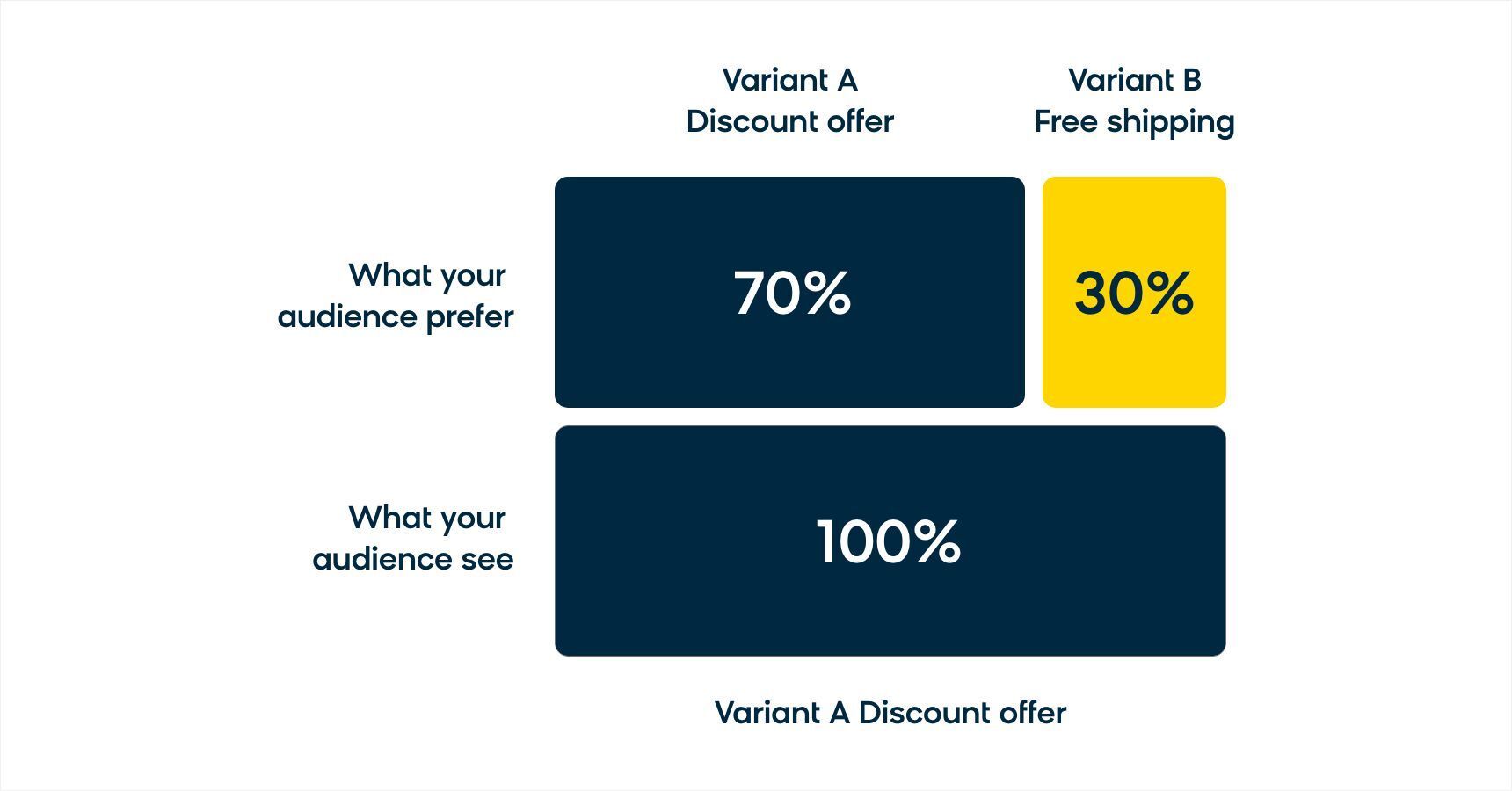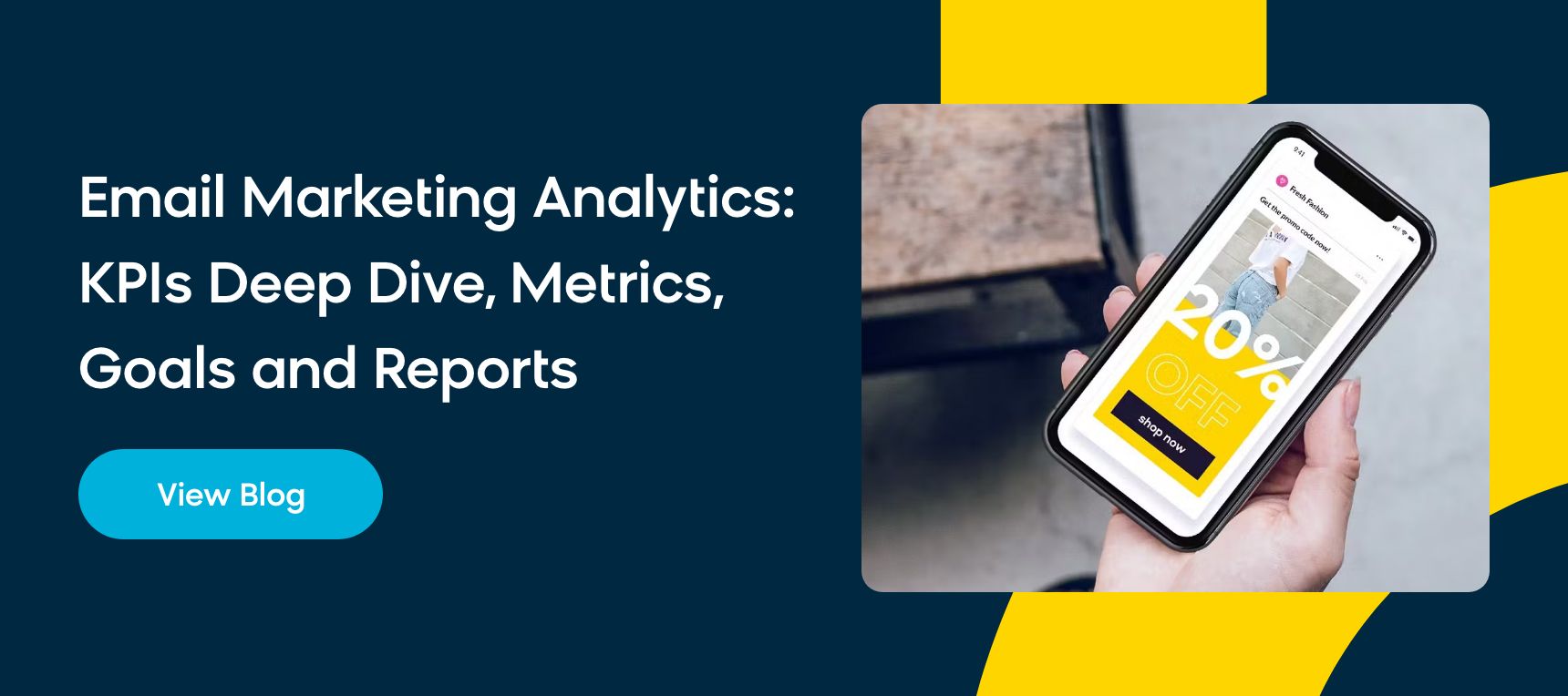The Ultimate Email A/B Testing Guide
By Ian Donnelly
02/07/2024

Email marketing is a crucial component of any digital marketing strategy, and A/B testing is one of the best tools that companies can use to maximize their email effectiveness.
Most marketers have heard the familiar mantra of “test everything and test often,” but what exactly should you be experimenting with? Are different subject lines the best place to start? How do you know which is the winning version? And what are the protocols of A/B testing that can help you get the most out of your email performance?
In this blog post, you can find answers to all your testing questions. We'll define what A/B testing is in email marketing, outline its benefits, identify some easy testing opportunities you should take advantage of, and list the best practices you need to keep in mind to create successful A/B tests.
We'll also show you what good A/B testing strategies look like in practice, map out the future of A/B testing in digital marketing, and discuss how AI can take your testing initiatives to the next level.
What Is A/B Testing in Email Marketing?
A/B testing in email marketing is a method of comparing two variations of a single variable to determine which performs better. At its core, it’s a simple process: You have two options, which you put into practice for likeminded audiences, and see which one makes the most impact.
In email marketing specifically, A/B testing involves sending two versions of an email to a small subset of your subscriber list, each with a different variable, and measuring which one generates the best results.
Once you've identified the winner, you can send that version to the rest of your email list with confidence.

What Are the Benefits of A/B Testing Emails?
The ability to test elements of your email campaigns is a game-changer for any marketing strategy. Here are just a few of the biggest benefits to incorporating testing campaigns.
Make Changes Without the Risk of Alienating Your Audience
Every business’ marketing efforts need to be adaptable and work towards better results, but refining and adjusting your campaigns can be a scary endeavor. You don’t want to jeopardize losing your audience’s attention with a new approach that you aren’t sure will work in your favor.
That’s why split testing is so valuable for modern brands — it allows you to experiment with alterations to your email campaigns without the need to test new ideas on your entire email audience.
By sending each test version to a small subset of your subscribers and letting the test play out at a small scale, you can be sure that the rest of your audience is receiving the best-performing campaign.
Fuel Your Marketing With Data-Driven Decisions
One of the biggest advantages of email A/B testing is how enlightening the results are, and how well they can inform your email marketing strategy.
A/B testing provides reliable first-party data to support decisions, rather than relying on assumptions or guesswork. This leads to better-informed marketing strategies and, ultimately, more successful campaigns.

First-party data is defined as information that a company collects directly via its own channels and sources. This is data that’s unique to your brand and audience, as no other company is able to collect these specific data points.
And with testing, your audience is telling your brand exactly how they feel about each of your specific variants — whether they like or don’t like a subject line, if they want to click through a specific image, or whether a certain call to action button appeals to them or not.
With data taken directly from your audience’s interactions, you can always make your marketing emails work towards your KPIs. No matter which email marketing metric you’re looking to improve, you can hone your experimentations to guide your audience toward your goals.
Each email test offers data that can tell you whether or not your changes make a positive or negative difference, like if your preview text has an impact on click-through rates, or if your short-form copy is affecting purchases. Every result can be used to reach your goals.
Make Your Best Performing Channel Even Better
One of the main reasons that companies A/B test emails is because email marketing is such a successful marketing channel, and improving your best tool for reaching your customers is an obvious best practice.
Email is the undisputed king of digital marketing channels, driving more sales than any other. And almost every statistic out there (and there are many) points to the continued expansion in email usage, preference, and ROI.

49% percent of shoppers enjoy receiving promotional emails from their favorite brands on a weekly basis, and half of them make a purchase as a result of marketing emails at least once per month.
But these impressive numbers can only be reached if your emails are performing well, and this takes time, effort, and a smart testing strategy. A/B testing allows you to make data-driven decisions on changes to your email campaigns, helping you achieve better engagement, click-through rates, and ROI.
Email A/B Testing Best Practices
To get the most out of your A/B tests, it's essential to follow best practices. Here are a few things to keep in mind to make your marketing emails the best they can be.
Test One Email Variable at a Time
The golden rule of testing is the simpler, the better. Limit your A/B tests to one variable at a time to ensure you can attribute any changes in performance to that specific change.
The variation between your testing campaigns can be as distinct as you’d like. You can try out whatever you think is worth testing, from small tweaks to the email copy, swapping out images, or experimenting with two different subject lines.
Just be sure to keep the number of variations at a manageable level so you can track and distinguish results easily. If you try to test too much at once, you won’t know which change influenced your audience to take action.
Have an Email A/B Testing Hypothesis in Mind
Testing for experimentation’s sake isn’t a smart way to craft a successful campaign. When you set up a test email, make sure to take the time and think about what you want your test to confirm or deny, and what it can do to make your future emails better.
Before running your test, have a hypothesis on how the change will impact the performance metric you're tracking. You want your experiments to either prove something right or wrong, which can inform next steps for your email marketing strategy.
Determine Your Sample Size
Creating your variations is important, but choosing who you send your tests to is just as vital. You need to make sure the audience that you test with is large enough to create statistically significant results.
Calculating sample size for your testing efforts depends on a host of factors — your target conversion rate, the number of total contacts you have, how long your testing window will be, etc.
Luckily, with the right email marketing software, this setup is easy to do.
Examine Any Statistical Significance
Once you've run your test, the next best step is to check for statistical significance before drawing conclusions.
You need to closely examine the results of your test to make sure any change in performance you observe between the two variations is not due to chance, but rather due to the tested variable.
To examine statistical significance, you need to compare the test group's performance against the control group's performance. The best way to do this is with statistical significance calculators or A/B testing software. These tools can tell you the probability that the difference in performance between the two variations is circumstantial or significant.
It's important to only draw conclusions from tests with statistically significant results. Otherwise, any decisions made from non-significant results could lead to worse email campaign performance. Make sure the data you collect is reliable and accurate to guide you to the best decision for your email marketing campaigns.
Know Which Metrics To Track in Email A/B Tests
Once you have your test results, you need to see how your original hypothesis played out. Tracking the right metric is crucial for gathering actionable insights — you need the right metric in mind to understand whether or not your winning variation hit the goal of your test.
The variable you’re testing for your emails will help determine which metric you should track. If you’re testing different subject lines, for example, open rates will be a deciding metric. For campaign content ideas, click-through rate and conversion rate will most likely show the winner.
Ultimately, testing results will vary for each brand. The KPIs you decide to track are up to you, and should be determined based on your intended goals.
Read This Next: Email Marketing Analytics: KPIs Deep Dive, Metrics, Goals and Reports
A/B Email Testing Ideas
The possibilities for testing different email variables are endless, but there are a few favorable places to start if you’re just beginning to test your campaigns.
Here are some ideas:
Subject Line
Test different subject lines to see which one generates the highest open rate.
Is your target audience more likely to click on a funny subject line or a more serious one? Does adding a recipient’s name to the subject line boost your conversion rate, or does an emoji in the subject line gain more clicks?
These are all worth testing out to cater to your customers.
Call to Action (CTA)
Experiment with the phrasing, placement, size, and color of your CTA button or hyperlink.
Does adding the price to your CTA move the needle on conversions? Does your audience find the phrase “Buy Now” more appealing than “Learn More”? Is a big, colorful button the key to getting more potential customers to the checkout page?
All these hypotheses are worth considering, and CTA variations are simple to test.
Email Copy
Test different versions of copy in terms of word choice, length, tone, and style.
Does long-form copy work better in your email body or do quick descriptions attract more clicks? Do marketing phrases entice readers to act or do customer testimonials inspire purchases?
Of all the testing elements, copy has the most room for experimentation. Learning how much copy your audience wants and the tone they expect from your brand is important to determine, and testing is a sure-fire way to craft the right voice for your emails.
Email Images
Try different images or graphics to see which ones resonate most with your audience.
Do full-email images help persuade your audience to click through? Do multiple images yield better results? Should you be advertising product shots, user-generated content, or lifestyle shots that highlight everyday use of your products?
A/B email testing is also the perfect medium to try out other visuals like GIFs and video content. It’s all about finding what works best for your ideal customer.
Design and Layout
Compare different design and layout options to determine which receives better engagement.
Do your customers want to scroll through longer emails or does quick messaging work best? Does breaking up your messages into sections help with conversion rates? What about your email’s color palette?
Making your emails stand out in your inbox with captivating design can make all the difference.
Email Delivery Day and Time
Test sending emails at different times or days of the week to discover the ideal time for your subscribers.
Are recipients more likely to click on your email during the morning or the afternoon? Do weekdays work best for your newsletter emails or would the weekend get more clicks? What about new product launches, sale announcements, or special offers?
The more you test with the right questions and metrics in mind, the better your campaigns will perform.
A/B Testing Email Marketing Examples
To understand just how valuable A/B testing can be for your marketing efforts, here are some examples of how Bloomreach customers have used A/B testing to improve their email campaigns:
River Island Enhances Email Program With A/B Testing
Popular high street fashion brand River Island had a successful email marketing program in place, but the company wanted to fine-tune its efforts with specific metrics in mind for optimization. Offering the best customer experience was the main goal, along with reducing the need for frequent emails to try and serve the right messages to the brand’s audience.
Using A/B testing, River Island was able to reduce the frequency of campaigns while improving KPIs across the board. The brand saw a 30.9% increase in revenue per email and a 30.7% increase in orders per email despite a 22.5% decrease in overall send volume.
Whisker Optimizes Customer Journeys With A/B Testing
Whisker, the company that introduced the first automated, self-cleaning litter box, wanted to create the best possible experience for its customers throughout the customer journey. To do this, the company decided to test just how impactful a consistent message across all its campaigns could be for converting its audience.
Whisker set up an experiment for its site that kept the same messaging from campaigns present at each touchpoint of the customer journey. Once a user received an email and engaged with the campaign, they would see the same campaign messaging that inspired them to click through and land on the Whisker homepage.
Whisker saw an immediate benefit to the experiment, with a 107% lift in conversion rate for users that received persistent messaging. Revenue also increased by 112% for every user that clicked through to the website.
How To Harness AI for Better A/B Email Testing
The one drawback of traditional A/B testing is that it relies on a majority to steer your marketing strategy. Whichever variant performs the best wins, and the other gets brushed aside.
But A/B tests don’t yield cut-and-dry results. For example, let’s say you ran an A/B test between an email offering your audience free shipping and an email with a discount code they can use at checkout. The results showed that 70% of customers are interested in a discount offer, and 30% in free shipping, so the winning variation would be an email highlighting the discount offer.

But what about the customers who engaged with the free shipping? They proved that this incentive was relevant to them, not the other variant.
This is where artificial intelligence can help, allowing brands to offer a level of ecommerce personalization that tailors messaging to each individual recipient.
Using Contextual Personalization To Serve the Right Message
AI-powered contextual personalization is the next stage of A/B testing’s evolution. It relies on artificial intelligence and machine learning — rather than human-defined rules — to make decisions about what to show customers by taking their individual context into account.
A customer’s context includes historical data about their relationship with a brand, such as clicks on your website, past purchases, opened emails, and so on. AI aggregates all this information for each customer automatically, analyzes these insights, and selects the correct variant based on this context.
Now the customers that are historically inclined to engage with a discount code will receive one, while subscribers who are more likely to enjoy free shipping would be served the other email.

This game-changing capability reframes the main question that A/B tests try to answer. Instead of “which variant is the best for everyone,” brands can ask “which variant is best for each customer,” and work towards finding an answer with the right tools for the job.
Read This Next: What Is Contextual Personalization?
Test Your Way to Email Marketing Success With Bloomreach Engagement
With A/B testing capabilities to help you find the winning variant and AI-powered features that optimize your email marketing in real time, Bloomreach Engagement has everything you need to test and perfect your emails and reach your goals.
Our platform is an omnichannel marketing solution that brings together all your customer data, automation, AI, and analytics in one place. Marketers can build personalized campaigns, test their results, and tailor all their communications to craft long-lasting customer relationships.
Looking for more ways to improve your customer experience and enhance your email marketing efforts? Learn how you can make your "test everything" goal a reality with Bloomreach.
Found this useful? Subscribe to our newsletter or share it.










